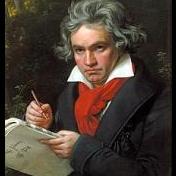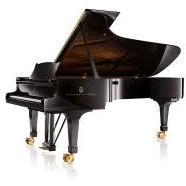Leaderboard
Popular Content
Showing content with the highest reputation on 05/15/2021 in all areas
-
Hi, here my new composition a Concert for Strings and Organ based the Rule of the octave, some ascending and descending progressions and some schemas of the Galant Style, such as the Romanesca, the Prinner, the Monte, the Fonte, the Ponte, Cycles of Fifths among others. I have been working on that the last few weeks, after reading Harmony, Counterpoint, Partimento by Job Ijzerman, which I find quite inspiring. I still have to explore the chromatic schemas probided in the book, which I will do in the next weeks. Strings have only Violin I, Violin II and Celli, because the texture is mainly of three parts. If someone is interested in the schemas I used and Baroque style, I will be glad to discuss about that. Any comments regarding the form are also wellcome. I didn't analyze any string and organ concert of the era. Probably Organ concerts have more interaction between Organ and orchestra, but I wanted some slow movements just played by the organ. The arrangement and form could typical of a so named "Church Sonatas", or sonate da chiesa, with the organ having more the role of a Basso Continuo rather than a solo instrument, though in Baroque style I think they are just played be solo instruments, usually two violin cello and organ as a continuo. The same arrangement I used is also the same used by Mozart in some of his impressing Church sonatas, just in a more classical style...Anyway, I think my composition is something in between a Concert for strings and organ and a Church Sonata.2 points
-
This one is a first for me in many respects. I don't think I've ever written a choral a capella piece like this before. I also came up with the Earth Day themed words to this myself (I thought about doing some kind of religious Latin text but I don't speak Latin and am not that religious so there goes that idea). The method for writing this piece is also quite a bit different for me and a first in this particular way of utilizing dice. I used a 12-sided musicians die to determine the key I would be writing in (A) and then used two regular 6-sided dice to come up with figured bass numbers. Near the end I decided to modulate so I rolled the 12-sided die again and it landed on Ab. Let me know if you like it or not! Also - if you have any pointers or observations I would love to hear them as I don't usually write for choir despite having been in one at one time or another. I put some breath marks in the beginning of the piece but didn't continue throughout the whole piece being kind of unsure as to where they should go. Thanks for listening! The words are in the pdf. For an updated (revised and extended) version of this choral piece go here:1 point
-
Thanks a lot for the nice comments! I'm glad you thought that the writing was idiomatic. About the modulation, In other works I've worked on, most not posted here on YC, I tend to modulate. The one I can think of was in the post called "Mozart-ian piece for oboe and strings.." etc, which you also kindly commented on, and you can check out the YouTube recording in the bottom of that thread if you haven't already 🙂 In this piece I didn't want to modulate actually, because I wanted it to feel "oriental" I guess, and persian music is more modal than tonal. But as Markus pointed out the Persia II sounds more western (and tonal), not connected to the first Persia. A thing which I agree upon.1 point
-
Very nicely change from part A to B, so different but complementary. Te ha quedado de fábula. Soft creative harmony in part B.1 point
-
I'm sure there is a rather complex set of rules with a lot of historical precedent about how dictionaries split syllables, but the rule is to follow the dictionary. You are right, you wouldn't pronounce it "nat-u...", you'd pronounce it "na-tu...," but this is why musicians are always reading ahead in the score. If you aren't reading ahead, you'll get notes wrong, rhythms wrong, miss dynamics, get behind the beat... and you'll also mispronounce lyrics. Of the dictionary rules I know, one is that prefixes and suffixes are always split off from root words as their own complete unit, so you get "in-tens-i-fy" instead of something like "i-ntens-if-y," you always split between double consonants, so "nat-u-ral-ly" actually obeys the double consonant rule and the splitting of a suffix rule, and then there are some rules about how you divide up chunks in words that aren't so clearly suffix or prefix. Partly I think the rules are meant to help chunk words into parts so that we pronounce the vowels correctly, even if we aren't reading ahead, since in English the way we pronounce our vowels is variable, but often follows a pattern based on the consonants around the vowel. If "pattern" was chunked as pa-ttern, you might read the first syllable as "pa" rhyming with "father," but if you chunk it as "pat-tern" then you intuitively read it as "pat" rhymes with "hat." It's a rule for a reason, even if we don't always know the exact reason. (My neighbor edits dictionaries for a living, so she might be able to tell you why). 🙂. If you want a good guide to this sort of stuff, I highly recommend "Behind Bars" by Elaine Gould. She was an editor at one of the big music publishing companies for decades, and had sets of handouts for the junior editors she supervised to keep everyone consistent, which got longer and longer until they turned into a doorstop of a style guide book. It explains the current way major publishers do everything from writing extended techniques properly for timpani, to when to write a rhythm as two tied notes instead of a longer dotted note, to what order to put different combinations of instrumental parts top to bottom on your score. It's not that people can't read the music if you do things other ways, but some ways are clearer on the page for one reason or another, (she often explains why), and if we all do things the same way, people get used to the pattern and don't have to think about it. Spelling rules don't always make the most sense, but if we all agree to spell everything the same way we get used to it and don't have to stop and puzzle over what someone was trying to say. And when there are rules that the major music publishers have agreed to, if you ignore them without a good reason, your score looks like a social media post about conspiracy theories full of WEIRD all-Caps, LIKE YOUR CRA-zy relative wrote it. And yes, each choral part always gets its own set of complete dynamics, even if it's homophonic. Two or more parts don't share dynamics. (They can share lyrics, though). That's another rule. Order "Behind Bars." You'll love it! 🙂1 point
-
I tend to agree. With fairly long notes the singers would sing Naaaaaa- tuuuuuu-raaaaaa-lyyyyy. sort of thing, not cut off the first vowel: Nat uuuuuuuu-raaaa-lyyy etc. One has to use one's instinct at times. Sometimes the phonetics suggest something different from an official 'splitting' of words. Sometimes even part of a phrase or word is ok if it seems to fit. Of course, ultimately it'll be settled when it's performed. (Things sometimes get changed in the cold light of live performance!). As it stands it's pretty good wordless and is worth congratulation for the rendering. (Edit: I too have a set of dice including a 12. I'll have to experiment!)1 point
-
Wow - thank you for that long and helpful response! That's exactly what I needed I think - I might just sit down and revise this piece according to your advice sometime in the near future. Somehow though when I pronounce "naturally" I don't see how I can possibly include the 't' sound as part of the first syllable - it sounds like it belongs as the beginning of the second one ("na - tu -ral - ly"). I don't know why the dictionary splits the syllables the way it does but it just sounds much more natural the way I have it LoL. I also have a question - with a choral score like this usually everyone sings from a copy of the whole score rather than individual parts - is that correct? So, let's say the music is homophonic - can I write only one set of dynamics for the whole choir or does each individual part within the score require separate dynamics? Thanks so much for your comments!1 point
-
Congrats on your first foray into choral writing! If you wanted to clean up your score a bit, following current conventions for your text will help it look its best. Single syllable words spread over multiple notes, including tied notes, are written with an extender after the word like this: "And___," "Let___." Use a slur over the notes to make it clear that they all go to the same syllable. Multi-syllable words spread over multiple notes get hyphens within the word: "Nat-u-ral-ly." Use dictionary conventions about how to break up syllables, (just look each word up in an online dictionary that shows it broken up into syllables): "Nat-u-ral-ly," instead of "na-tu-ra-lly." If the last syllable of a multi-syllable word stretches over multiple notes, including tied notes, it gets an extender at the end: "Nat-u-ral-ly___." Any punctuation or capitalization in the original text source should also appear in your score. (Since this is your own text, you can do whatever you want). If you repeat a word, a phrase, or a whole line of text, separate the repetitions with commas and then end with whatever punctuation was in the original. If you repeat text that starts with a capital, you can choose to just capitalize it the first time, or capitalize each repetition. "Happy birthday to you, happy birthday to you. Happy birthday dear..." or "Happy birthday to you, Happy birthday to you. Happy birthday, dear..." Just be consistent within the piece. As for adding breaths, you can put them all in and know that choral conductors may instruct their singers to disregard some of them if they have enough people to stagger breathe and prefer to carry the sound through instead. You can put some of them in that feel particularly obvious and leave the singers to decide the rest for themselves, or you can put none of them in and let the conductors decide what they want. You can mark them with as you have done: ' . Or you can shorten the note duration and add a rest to show exactly how long a breath should take. You can even put a suggested breath in parentheses to indicate that someone might want to breathe there, but then again, they might not: ( ' ). Personally, I try to mark any breaths that feel particularly necessary. If there is a long phrase where there is no good place to breathe, I make sure to mark best spot to breathe just before it, so everyone will be well-prepared to make it through the long phrase gracefully. If all the singers are moving together in rhythm homophonically, then it's usually easy for the conductor to conduct a breath that everyone will follow, so I don't need to mark it, and if I do mark it, I don't need to specify exactly how long it should take with a rest. Everyone will just follow the conductor and the conductor may decide to push or pull the tempo and want to change the length of the rest a little for expressive purposes. Best not to mark it at all, or just mark a breathe without specifying the duration of the rest. But when there is a lot going on rhythmically and the piece is polyphonic, different parts may need to breathe at different times, and the conductor may be too busy keeping everyone together to clearly cue a breath for each part, so I am more likely to mark a breath where it seems to make sense, or just add a rest to the part to show exactly how long it should take. Hope that's a help!1 point
-
Wow! This piece totally blew me away! Very nice job! I personally think your first foray into string quartet writing - the third movement - is the best (or at least my favorite). I am not even well versed enough in string quartet writing to know how to more critically examine this piece! Like for example - what do the arpeggios mean with the triangle notes? (I am not talking about the diamonds which indicate artificial harmonics) I tried looking it up and the only answer I can come up with is that triangles are used to indicate "the highest note possible" on the instrument but I don't think you're using them in that way? The notes sounded pretty distinct to me in the performance rendering. Anyways - great music! Thanks for sharing!1 point
-
Thank you all! I've taken your advice into account and updated the score slightly. I'm still not completely happy with the dynamics and the tempo but hopefully it will be more balanced when it is played live. I have to give the final version by Monday. Please feel free to offer any other feedback!1 point
-
Yes, a very nice madrigal styled piece if perhaps short. The twists of harmony are most engaging and the piece is well-crafted. It just flows. Hopefully this won't be your last choral piece. You have some impressive results with the dice. Aleatoric, eh?! All good. Cheers!1 point
-
I found this piece to be quite nice overall. Personally, I feel that it could have improved with a little bit more variation and development of the themes you presented, although what is here is quite lovely.1 point
-
So, I've noticed this whenever I compose for woodwinds, be it as part of an orchestra or a woodwind quartet. Some blends are better than others. Sometimes it has to do with the dynamic curves being similar, like with the Oboe and Bassoon blend, but other times, I can't really seem to explain it. In terms of dynamic curves, I'd say these are the best pairs: Flute and Clarinet Oboe and Bassoon And of course, there are these 2 classic blendings: Flute and Oboe in thirds Flute and Bassoon in octaves When I try to blend the Flute and Clarinet, I often have the Clarinet an octave below the flute, partly because that's usually where it falls when I am doing a full orchestral tutti chord. And sometimes it works beautifully and sometimes it doesn't seem to work at all and Oboe and Bassoon seem to be better choices. But why? I mean, the dynamic curve of both the Flute and Clarinet is quiet low register up to loud and strident altissimo register, whereas both the Oboe and Bassoon have a natural diminuendo from low to middle register and then the dynamic curve goes up. Bassoon and Clarinet, I generally don't have problems with. Same for Oboe and Clarinet. Probably because they are all reed woodwinds. Flute and Clarinet seems to be the one and only woodwind blend that either works beautifully or doesn't work at all. Even adding the Oboe in thirds with the Flute or the Bassoon an octave below the Clarinet doesn't always make that blend work1 point
-
Oh, nope. The first thing to keep in mind with woodwind writing is that it's not like writing for strings. Writing for brass is quite analogous to writing for strings, because each of the 2 families is relatively homogeneous (strings almost perfectly homogeneous, brasses a bit less so because you have are 2 kinds of bore). Also, each instrument is quite homogeneous along its register. Each woodwind has 2-3 registers with completely different characters, and each instrument has a completely different waveform (e.g. clarinet has no odd-numbered harmonics, while the others have), which kind of defeats the whole harmonic series thing (and the series thing should only be a loose guideline, never a dogma). Now, it is possible to write in rather open voicings, but but the default is close voicings (Rimskiy says it, and probably Adler says it too). Also, when I said "close voicing", it assumes the bassline is completely independent, so the bassoons can be far away from the rest. Another takeaway from Rismkiy is that if you only have a woodwind quintet and nothing else (didn't know that was your aim), blend will be an issue constantly, that's why most woodwind quintets eschew it almost altogether (esp. if you have no horn) and focus on counterpoint and other non-blended sonorities.1 point
-
There are 2 main things to consider if you want a "blended" woodwind sound: 1) All the instruments must be in either their "strong" or "weak" register. Adler's book has charts with all this, but I recommend reading the whole treatise. 2) Chords should be voiced in close position, i.e. without huge gaps. That's explained in Rimskiy's book, and there can be some exceptions, but these are quite rare. Also, horns are very often used to enhace the blend, especially in pre-20th century music. They aren't technically a woodwind, but can act as one. If you want to split hairs, I recommend Koechlin's treatise, but it's (AFAIK only) in French.1 point
-
The string orchestra sounds good because of phasing. It's actually, aside from guitars, basically one of the only ensembles that benefits from phasing. It's for this reason I don't necessarily think String Quartet vs String Orchestra is the best example. Especially since, in both cases, you can still have the same number of parts, just a different number of players per part.1 point
-
It's a long time since I've had anything to do with strict counterpoint but without a very detailed look at your score everything seems ok. The strict rules are about intervals and the moving of parts. You've achieved renaissance polyphony because each part is a part in its own right and I can see no "illegal" intervals or movements. However, it sounds liturgical and is a solemn (if pleasant sounding, atmospheric) Kyrie. So, answering your questions: The form is ok; you don't seem to be breaking any rules; What next? I'm only familiar with the Anglican service and unless I'm mistaken doesn't a Gloria in Excelsis follow? Why not just call it a Kyrie (if you intend to produce a full service)? All good.1 point
-
About the string orchestra vs. string quartet debate - I think the string orchestra yields a completely different tone color than individual string instruments in a quartet and I tend to prefer the string orchestra. The combination of string instruments in an orchestra yields a whole that's somehow greater than the sum of it's parts - a more "padded" and subtle sound. Let's not also forget that the string orchestra has double basses which expand the orchestra's range considerably in comparison to a quartet. Also, the balance in an orchestra is better in my opinion as violins in a string quartet tend to dominate and even if you stick a contrabass into the quartet making it a quintet, the instrument doesn't really have a comparable dynamic range on it's own (when doubled however, I think this problem is remedied a bit). Anyways - a string orchestra is more versatile dynamically and in it's range is my point.1 point
-
I think it sounds as renaissance polyphony would be expected to sound although I am far from knowledgeable on that subject much less vocal music in general! Any particular reason or purpose why you are trying to emulate renaissance polyphony? Will you be having this performed? I know that even during those times in was not uncommon for some very dissonant passing harmonies (Monteverdi) to be utilized which you don't seem to do. I love choral/vocal music though that introduces and resolves some beautiful dissonances. Thanks for sharing!1 point
-
This is my first venture into composing video game music. I did this for the "7 Days of Video Game Music" composing challenge. (This is a youtube playlist with seven tracks, one for each day of the challenge.) All of the tracks were made in GarageBand, using mainly loops with some of my own elements added throughout.1 point
-
I really like the first Persia piece which I think you pulled off really well. To be frank, I don’t feel much connection at all with the sequel. It sounds much more influenced by western classicism. Perhaps you are trying to depict a medieval crusader army of knights riding to the holy land to reconquer the holy land from the infidels of the East.1 point
-
Hi Olov, I think this exemplifies some quite idiomatic writing for the string quartet! I like the pesante feel and your melodies are good. As a kind of general criticism I have noticed that you pretty much tend to hover around your home key without modulating. I think if you modulated to another key after stating your main thematic material it might open up your forms to secondary themes and also help you write longer pieces. That's my suggestion. Thanks for sharing!1 point
-
Coming at it from a producer's perspective, I do think there is something to using different keys. It has to do with how the frequencies interact as you get closer to the bass region of the frequency spectrum. This region starts to get much more sensitive to playing notes that are closer together because they are slower, so you hear the beating of the clashing frequencies more. Transposing a piece up will alleviate some of this "beating". So finding the right balance for your progression with the mood you're aiming for and with the right bass representation absolutely comes into play for me.1 point
-
Hi @PaperComposer, thank you for your comment, and sorry for the late response. That does make sense to me. I'm lucky enough to have perfect pitch so I don't have to check with a reference, but I always write down the music in the key I heard it in my head. I read an article about Baroque tuning, which said that the reason that 'concert pitch' is higher now is that it sounds more intense or excited than the low A432 or even A415. I heard a recording of Chopin's nocturne op 9 no 2 where the piano was tuned a little higher than normal - I noticed that the music sounded overly bright and a little harsh. Since I created this thread over a year ago, my opinion has very much changed. Before I would say that keys had very specific emotions, but having learnt considerably more about music and explored more repertoire, my answer would now be no - I now choose keys based on the instruments and their ranges.1 point
-
Since you are still active on the website I decided to give this old thread a go LoL ... In short - I don't know how I pick the keys I pick. I simply sing or hum or whistle the melody while I'm coming up with it and check what key I'm in against a tuning fork or the volume button on my cell phone and I try to keep it in that key. Very rarely I change the key of the piece I am writing to better suit the necessity of the instruments - like my last Piano Quartet in G# minor was originally in G minor but I had to transpose it up a half step because I needed the cello to be able to play a leading tone to C minor in the 2nd theme of the form - since that happens to be a B below the staff in bass clef (and I wanted to avoid a scordatura tuning for the cello) I transposed it so the leading tone becomes B# (or C) in the new key of C# minor for that section. I do believe that different keys have different psychologies I just don't think they are what we think they are. Hearing a piece a half-step or a step higher than one is used to might make it sound for example a bit more bright (until one reaches a certain limit where the instruments would have to be re-arranged to be in an appropriate range). Same if you transpose it down. It can have a very artificial sounding effect on the music at first when one is not used to the new key. I think it's because of this brightness/darkness factor.1 point
-
I definitely think that playing pieces is at least part of what lead me to define the emotion for some keys(such as for example the most variable key being C minor) but I also think that my own improvisations are also part of it. For example, when I improvise in F minor, I find that it always sounds very sad, like it is The Key of Death. But when I play for example Piano Sonata in F minor op. 2 no. 1, it doesn't sound sad, rather it sounds dramatic. Chopin's F minor Ballade also doesn't sound sad to me. And yes, I do experience a change of mood with transposition.1 point
-
I myself have specific emotional associations with certain keys. I will separate this into a major and minor list. Major Key Emotions: C major - Happy boredom in most conditions G major - Completed a minor task or in general, warm D major - Majestic A major - Bouncy, staccato reinforces it E major - Triumph over something major B major - Dreamy, Figuring out what to do next F# major - Dreamy, Jazzy C# major - Eternal Db major - Dreamy Ab major - Dreamy, Flying and enjoying it Eb major - Sleeping in a field of flowers Bb major - Moonlit night F major - Flowing along a river Minor Key emotions: A minor - Completely neutral key, as if the sadness of D minor and the happiness of C major canceled out, and left this void of a key that is A minor E minor - Lost in a maze B minor - Mountain climbing, Working hard F# minor - Saddest of the sharp minors C# minor - Peaceful evening Ab minor - Mysterious G# minor - So uncommon I don't have an associated emotion unlike with C# major Eb minor - Jazzy, even with a completely regular rhythm Bb minor - Naturally angry, regardless of tempo or dynamic F minor - The Key of Death, Unrelievably sad C minor - Most variable of all the minor keys. Any emotion is easy to get across G minor - If it comes after a dramatic passage, Calming down, Otherwise, variable D minor - A tad sad, Uncertainty The fact that C major sounds to me like happy boredom, along with the fact that a small bit of chromaticism makes me question whether or not it actually is in C major, and that C major is the most common key in all of music, is why I have it as my one and only avoid key. Now all these emotional associations are just from my experience as a pianist. I realize that different instruments playing in the same key can sound completely different in terms of emotion, even if the music that is played is exactly the same.1 point

.thumb.png.8b5b433a341551e913a34392660bc95b.png)




.thumb.jpg.c0a72d70ca19ec34c5702ec7e7951f37.jpg)

